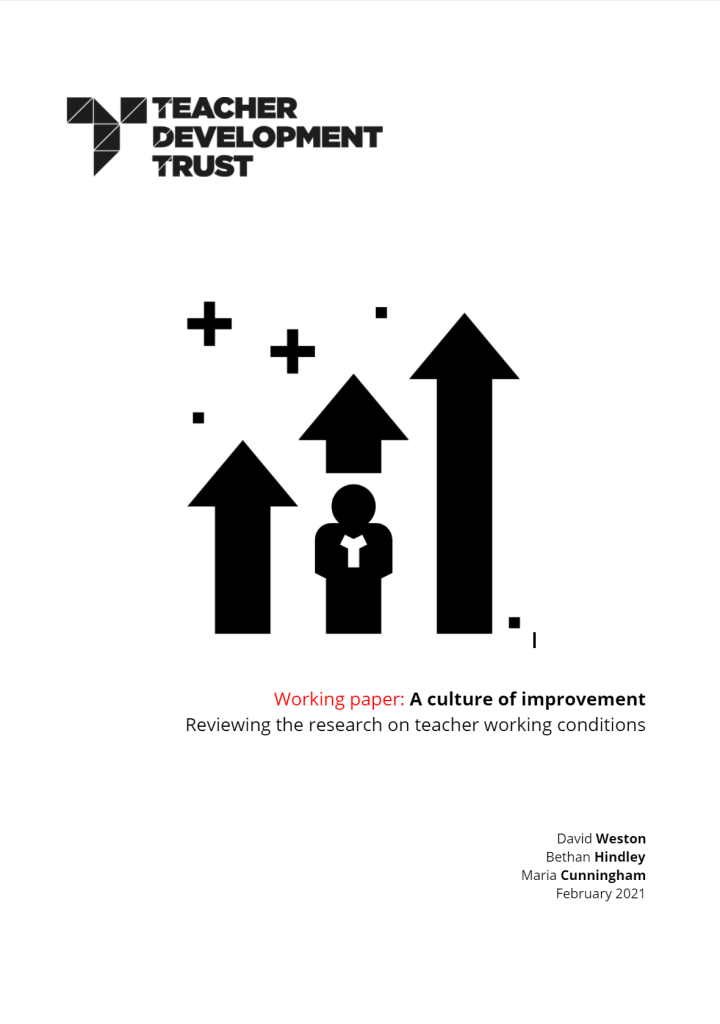““Great leaders do not create followers, they create more leaders” – Tom Peters
From hero headteachers to empowered expert teams, what can school leaders do to help boost teacher wellbeing and avoid burnout in schools? And what part does professional development play?
We’re pleased to welcome guest blogger and valued TDT partner Jane Kennedy, Lead Advisor Professional Learning & Commercial Engagement for Education Durham. Here, Jane offers an honest exploration of what, in her experience, wellbeing means for staff in schools, along with some helpful reflection questions for us to take away. She offers some thoughts on how we might not only attract great teachers but also develop, empower and retain them to build expert schools where teachers thrive and children succeed.
Well-being, or more simply, whether we can “feel good” and “function well” in our professional roles (NEF)(1), remains a pressing issue for school leaders. Arguably now, more than ever, school leaders carry an unyielding amount of pressure, made ever more challenging by the undeniable erosion of support systems around them.
The shrinking of the shared pot of funding and the decline and demise of services once deemed crucial to schools has, of course, played out in different ways for different schools. And if the system is under pressure, we can be sure that teachers themselves are too.(2)
The Need for Improved Teacher Wellbeing

Now let’s be honest, teaching is hard, it is demanding, and it is relentless. If anyone makes the journey into teaching expecting an easy gig, they are quickly disappointed. But it is the challenge, the never-ending demand, the constant need to be learning, thinking and problem solving, the continuous need to reflect upon and improve your individual practices, and the opportunity to be working with the most challenging and inspirational young people that make it magic.
Teachers make a difference.
They support growth and innovation; they have enabled the progress that the world sees daily. Who would not want to be part of something that has the capacity for so much good? And teachers know this. Ask them why they do it, and they will tell you it is because it is what drives them to get up day in and day out and get into the classroom or lead a school.
The Pressure on School Leaders
The need to ensure wellbeing is being addressed across a school is no small ask, and today’s climate is causing school leaders to feel under tremendous stress and pressure. Headteachers are so busy trying to protect their staff that their well-being is suffering.
To reduce workload demands, senior leaders take on more work or avoid asking for essential work to be completed and as a result, everyone suffers. Over the last five years, headteachers have taken on so many additional demands, and for many, the only way forward was to buckle down and keep going. This is simply not sustainable.
The cracks are not just showing; they are gaping and swallowing up substantial numbers of headteachers and school leaders who have decided enough is enough and left the profession. Strangely enough, there are not enormous numbers of would-be school leaders clamouring in the wings. There is a natural reluctance to step into school leadership because colleagues have seen what it does to their fellow leaders, and it isn’t good!
Read our Blog: Why is Teacher Wellbeing Important?

What Can Senior Staff Do About Teacher Working Conditions?
The sad fact is that deep down, we know how to start fixing this. We have the evidence base, the research papers, and the professional wisdom to be able to suggest the path forward, but what we still don’t feel we have is the permission or the bravery to set out on that journey.
There is no silver bullet or quick fix. Let’s accept that from the get-go. This cannot be checked off after a tremendous team-building session or a field trip out with colleagues (if people even have the time and energy to go along to these!) But there is a way forward.
How can we truly make a positive impact on teacher well-being and, in doing so, support the well-being of the school leaders in the process? How can we ensure that our schools can function well because the people who make it thrive and feel good?
The Way to Staff Wellbeing Improvement?
 In the TDT’s working paper, A Culture of Improvement: ‘Reviewing the research on teacher working conditions’, the link between teacher improvement and their working environment is made. It cites the critical importance of the school leader in building and nurturing a positive school environment, but how can a school leader take on that responsibility if they are burnt out and overwhelmed?
In the TDT’s working paper, A Culture of Improvement: ‘Reviewing the research on teacher working conditions’, the link between teacher improvement and their working environment is made. It cites the critical importance of the school leader in building and nurturing a positive school environment, but how can a school leader take on that responsibility if they are burnt out and overwhelmed?
The report lists five aspects of teachers’ working conditions that can lead to improvement:
- Creating opportunities for effective teacher collaboration to explore student data, plan and review lessons and curricula, and plan and moderate assessments,
- Involving teachers in whole school planning, decision-making and improvement,
- Creating a culture of mutual trust, respect, and enthusiasm in which communication is open and honest,
- Build a sense of shared mission, with shared goals, clear priorities, and high expectations of professional behaviours and students’ learning and
- Facilitating classroom safety and behaviour, where disruption and bullying are rare, and senior leaders strongly support teachers in their efforts to maintain this classroom environment.
Just read the first four bullet points, and there we have it tackled: teacher well-being, leader well-being, and school well-being.
Building Better Cultures within Schools
Being a team is more than just name; it is all about a school’s culture, trust, relationships, and climate. Get that right, and we are unbeatable. We feel good, work well, are supported, and support. We are integral cogs in a machine that only works when all the cogs are running smoothly. We feel valued and necessary, and the sun is shining. Yes, we have days when not everything goes smoothly, and yes, there are times when we are disappointed, tired, or just not firing on all cylinders. But, on those days, we must remember all the other times when things are working well, and that and the support of our colleagues can get us through.

The final bullet point in that list above could be argued to be an effect of getting the other four in place. If we take the time to build teams of teachers who know and trust one another, we will often also find ourselves with teachers who:
- Have open, honest and robust professional discussions
- Are not afraid to talk about the real issues or unpick those 3 a.m. worries
- Are comfortable in sharing areas of weakness and strength
- Will open their professional toolkits and share their expertise and resources
- Will open their classroom doors and inviting others in
- Will model collective responsibility and mutual respect, tackling behaviour issues
Getting into The Thick of it
We are not sitting above this. We are in the thick of it with our sleeves rolled up, sharing our vulnerabilities and leaning on the support of colleagues. We are bringing them into our worlds to help us deal with everyday problems and crises.
So, if we genuinely want to support well-being in school, perhaps we attempt the enormous challenge of building and nurturing vibrant and positive school cultures and climates.
Sitting in an ivory tower and pontificating can be easy in my current role. I have a job where I can carve out moments to read the research and investigate the evidence. I have the privilege of visiting schools and talking to professionals from across the education spectrum as a daily part of my job. I can reflect on what I see, hear, and experience. I am very aware that I have the head space and wherewithal to engage with a vast array of support and guidance. My role is grasping everything I can experience and sharing it with others both practically and in manageable ways. I must make the research workable so that it helps teachers and, in doing so, supports young people.
Practical Suggestions for Leaders to Improve Staff Wellbeing In Schools
I can’t afford to say the words and pay lip service to the importance of well-being without offering some suggestions about how we can practically tackle the pressures together.
So, here are some of the suggestions and reflection questions I want to pose to encourage the conversation on how to develop and sustain a supporting culture and climate.
Kraft and Papay (2014) offer the following model to support strong school climates:

What could this look like in action?
Nurturing Supportive leadership
Top tips for action:
- Visit each classroom and join in with a lesson, not to observe but as a low-stakes way to support your team member. Enjoy the lesson and be part of the learning.
- Tell the truth. Transparency is essential in building trust. Don’t sugar-coat problems the school faces but share them openly and ask for suggestions and perspectives. Then, listen and act on them, where possible.
- Set aside time to talk to every member of staff about their professional aspirations, challenges, and their personal route for progression.
Reflection questions for your journal:
- Think back over the last few interactions you had with colleagues. Did you show any vulnerability or ask for any help?
- Which members of staff present you with the most significant challenge? How have you built a relationship with them?
- Do your staff feel valued? How do you know?
Find out about our Course for Leading Professional Development in Schools
Giving Opportunities for Teacher Collaboration
Top tips for action:
- Rethink staff meeting time. Consider how that time could be used more effectively to allow colleagues to collaborate on new initiatives and share best practices.
- Encourage staff to share their ideas and suggestions to move the school forward. Actively acknowledge these ideas and consider discussion time to unpick their feasibility together.
Reflection questions for your journal:
- Do you feel confident your staff will prioritise aspects of work that will lead to school improvement? How do you know?
- How might you lead from the front without dictating?
- How are individual teacher strengths recognised and celebrated? How is their expertise utilised and shared with others?

Setting High Expectations
Top tips for action:
- Believe in every member of the school community. Take time to know them, understand them and listen to them.
- Challenge ourselves. Every time we dismiss something as being the way it is because it is inevitable, we need to hold ourselves to account for this.
- Take on the big challenges, make public promises and show by our actions that we care and are trying, day in and day out.
Reflection questions for your journal:
- What are the mindsets that stop your school from setting high expectations?
- What is your school community’s understanding of high expectations?
- What does success really look like? How close are you to achieving this success?
Fostering Collective Commitment
Top tips for action:
- Take real time to unravel what key values form the backbone of your setting.
- Challenge, interrogate and argue the worthiness of every one of those values and invite and listen to all voices.
- Invite (external) visitors to share what they see to say what they think your core values are.
Reflection questions for your journal
- What are the key values in your school?
- How do you inspire others to join you in your dreams and aspirations for the school and its pupils? How do you join others in theirs? What does that look like in practice? How are those values embedded and enacted?
- Who wrote the school vision and the intent statements? Who decided on the inspirational quotes on the wall?
- How confident are you that every member of your school and wider school community would be able to articulate those values and how they impact them individually?
Concluding Thoughts
These are not checklists to grade against. These are some thoughts and ideas on teacher wellbeing. Together, across the profession, there is a wealth of great ideas, fabulous approaches and tried and tested solutions, so these are just the start.
To use that well-known quote from Dylan Wiliam, I absolutely agree, ‘…nothing works everywhere…’, but in the same vein, we can categorically state that something will work everywhere; we just need to find it.
We can do that so much more effectively if we trust our collective professionalism and work together.
 About the Writer
About the Writer
Jane is a primary school teacher who left the classroom ten years ago. She joined a team at the local authority committed to supporting schools. They are committed to supporting teachers in developing into the best possible teachers they can be, and this is driven by effective professional development. She now leads the professional learning arm of Education Durham and spends her time creating and delivering professional learning opportunities for teachers across the region. To achieve this, she must constantly learn, engage with new ideas and dig into the evidence and research.
She does this by engaging with national organisations such as TDT.
She believes TDT’s commitment to, and belief in, the essential need for teachers to have access to the highest quality of professional learning has led to a close collaboration.
Jane says she is not a writer or an academic, but she is, at heart, a teacher and, most importantly, wants to remain credible. She says, “In the end, all the research in the world means little unless it can be actioned. If my words can help others to grapple with the big ideas in education, work through academia and methodologies and make sense of research so that teachers can improve how they teach, then I am happy, but they are just my words, ideas, and ponderings and as such you can choose to agree or disagree – so long as you join in the conversation.”
References:
- Michaelson, J., Mahony, S. and Schifferes, J., New Economics Foundation (2012) Measuring Well-being: a practitioner’s guide. Accessed : 8d92cf44e70b3d16e6_rgm6bpd3i.pdf (neweconomics.org) [retrieved August 2023]
- Weston, D., Hindley, B., & Cunningham, M. (2021). A culture of improvement: reviewing the research on teacher working conditions. Working paper version 1.1, February 2021. Teacher Development Trust. Accessed: https://tdtrust.org/coi/ [retrieved September 2023]
- (1) New Economics Foundation (2012) Measuring Well-being: a practitioner’s guide. Last accessed 23.08.2023 8d92cf44e70b3d16e6_rgm6bpd3i.pdf (neweconomics.org)
- (2) Vina Sharma, TDT, Bite-sized Wellbeing, 2023.

